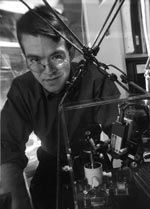MIT graduate student Brian Hubert of Yakima, WA, who carries a notebook everywhere and leaves it on his night table to jot down middle-of-the-night inspirations, has been awarded the seventh annual $30,000 Lemelson-MIT Student Prize for inventiveness.
"I've been inventing for years, and this award is a wonderful capstone on my MIT experience," said Mr. Hubert, who received the SB and SM in mechanical engineering with a minor in piano performance in 1996. "The Lemelson-MIT Program is unusual because it not only recognizes academic excellence and technical achievement, but it also recognizes the contribution and importance of inventors and inventiveness. I'm glad to be part of its heritage."
The judging panel selected Mr. Hubert, a doctoral candidate in mechanical engineering, for the breadth and variety of his designs and innovations. Mr. Hubert has a lengthy list of accomplishments in diverse fields that include microfabrication technology, computing, music and architecture. The award was presented at the Faculty Club on February 15.
Mr. Hubert, a PhD candidate, plans to use his prize money to create fabrication methods for electronic devices, such as those found in the plastic memory chip he invented. He plans to perfect new low-cost techniques for products that require microscale and nanoscale resolutions, such as the development of inexpensive memory and computer chips, flexible displays and disposable genetic analysis devices. His goal is "to make intelligent products so rapidly and cheaply that we could incorporate them into almost everything."
Mr. Hubert was introduced as the winner by Dr. Robert Lemelson, son of the late Jerome H. Lemelson, a prolific inventor who founded the prize program with his wife Dorothy in 1994. Dr. Lemelson said this year's winner and his father had a lot in common, including the notebooks that each carried everywhere. "My dad would get up three or four times a night to write down ideas," said Dr. Lemelson. Mr. Hubert replied, "I would have been pleased to interact with the late Jerome Lemelson."
In addition to his notepad, Mr. Hubert has scribbled ideas on everything from tissue paper to tablecloths. He holds patents for two inventions -- an all-printed plastic memory chip and a superconductor fabrication system -- and has three additional patents pending. His "silicon-less" plastic memory chip can be easily and cheaply produced, is mechanically flexible and stores data when the power is shut off. This technology would be useful for smart cards, digital cameras and portable computational devices requiring cheap, high-capacity memory chips.
"I like to have a lot of fun with my inventions," said Mr. Hubert. "But I also take inspiration from what other inventors have done in times before. It's great to see how creative people in the past have solved technical problems; just think about what some of these great minds would have done with just a little gem of modern knowledge."
Much of his recent work is in the area of nanotechnology, which focuses on building things at the tiny scale of nanometers (one-billionth of a meter). Mr. Hubert, who has been working on his doctoral thesis research under Associate Professor Joseph Jacobson at the Media Laboratory, has developed the world's first universal "pick-and-place" nanoassembly machine. The machine is capable of picking up and assembling virtually any type of material, several thousand atoms at a time. Mr. Hubert likens the device to a child reaching into a box of LEGO toys to build a structure using different blocks -- the only difference being the structures assembled by the machine are one million times smaller in scale and one million-trillion times smaller in volume.
Mr. Hubert has also developed stock analysis software and a hip joint replacement implant. The software pinpoints investment opportunities in the securities markets by simulating nearly every possible combination of buying, selling, shorting and covering. The hip joint replacement implant mimics the bending action of a normal bone, yet exponentially increases in strength the more it bends.
In addition to his technical wizardry, Mr. Hubert is a gifted composer and concert pianist who has composed and performed more than 22 original works. He is also adept at architectural design and modeling, as evidenced by his plans for a house inspired by architect Frank Lloyd Wright.
A version of this article appeared in MIT Tech Talk on February 28, 2001.






